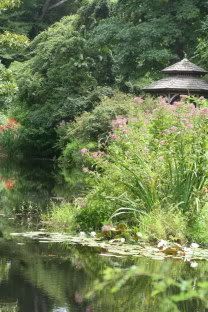 Yesterday I took a drive to Cape May County to visit two gardens: Leaming's Run Gardens in Swainton and the Model Backyard Habitat at the Cape May Bird Observatory Center for Research and Education in Goshen. I've visited both gardens in the past, but always early in the Spring before things are growing well. I went yesterday hoping to see each in its prime.
Yesterday I took a drive to Cape May County to visit two gardens: Leaming's Run Gardens in Swainton and the Model Backyard Habitat at the Cape May Bird Observatory Center for Research and Education in Goshen. I've visited both gardens in the past, but always early in the Spring before things are growing well. I went yesterday hoping to see each in its prime.Leaming's Run bills itself as the largest annual garden in the East and a *mecca* for hummingbirds in August. I had high hopes, since my visits in previous years were so early in the season that the gardens didn't look like much,
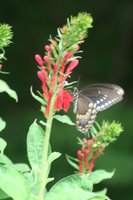 having been only recently planted.
having been only recently planted.The gardens were pretty enough, but my overall impression was that the plantings were repetitive and sterile. Granted I was less interested in the plants than I was in what was attracted to them, but I think they might include a larger variety of annuals in their 20+ individual gardens. I left having seen one hummingbird and a few swallowtail butterflies; disappointed that I had driven more than 2 hours to see many of the same flowers I have at home and fewer hummingbirds or butterflies.
I was glad to have a *back-up plan* for the day. Less than five miles away is CMBO's model backyard ha
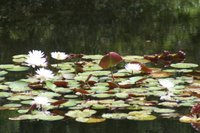 bitat - full of pretty flowers and teaming with life. Maybe not as colorful or as neat, but certainly more interesting to the likes of me! The gardens are maintained by volunteers and are inventoried regularly for birds, butterflies, and dragonflies. Plantings are done with wildlife value as the focus. There is a wildflower meadow, dragonfly pond, Purple Martin colony, and the native trees, shrubs, and flowers are planted to benefit hummingbirds, butterflies, and other pollinators. All of the pics in yesterday's post were taken in these gardens.
bitat - full of pretty flowers and teaming with life. Maybe not as colorful or as neat, but certainly more interesting to the likes of me! The gardens are maintained by volunteers and are inventoried regularly for birds, butterflies, and dragonflies. Plantings are done with wildlife value as the focus. There is a wildflower meadow, dragonfly pond, Purple Martin colony, and the native trees, shrubs, and flowers are planted to benefit hummingbirds, butterflies, and other pollinators. All of the pics in yesterday's post were taken in these gardens. The most popular plantings yesterday were a few very lar
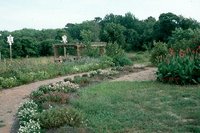 ge patches of mountain mint which were teeming with beneficial wasps and butterflies. There must have been at least a dozen hummingbirds in residence, each staking a claim to a particular feeder or flowering plant. A gentleman was there counting butterflies and told me he had seen at least 32 different species in just a few hours. The garden even caters to the taste of certain butterflies fo
ge patches of mountain mint which were teeming with beneficial wasps and butterflies. There must have been at least a dozen hummingbirds in residence, each staking a claim to a particular feeder or flowering plant. A gentleman was there counting butterflies and told me he had seen at least 32 different species in just a few hours. The garden even caters to the taste of certain butterflies fo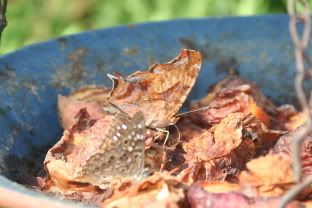 r rotten fruit. The picture at left shows a Hackberry Emperor (front) and a Question Mark *nectaring* on smelly rotting fruit. I've never seen either of these butterflies before and found it interesting to see how well camouflaged they are in this pic with soupy apples and peaches as a backdrop.
r rotten fruit. The picture at left shows a Hackberry Emperor (front) and a Question Mark *nectaring* on smelly rotting fruit. I've never seen either of these butterflies before and found it interesting to see how well camouflaged they are in this pic with soupy apples and peaches as a backdrop.The visit to these two gardens, each with a particular focus, really brought home to me the value of planting with wildlife in mind. The first, while planted to draw a particular species (I never saw so much cardinal flower and that horrible red salvia in one place!) was so much less pleasing because it held no variety. The second, which represented a variety of habitats in its plantings was much more attractive and interesting - to me and the *wildlife* it provided for.
Note: The pic of the habitat garden (above right) is from CMBO's website. Click on it for a link to one of many excellent articles on planning a wildlife garden.


5 comments:
Sounds like a nice day. I think I will add mountain mint to my garden. Watching the visitors to the garden is one of most enjoyable parts of gardening.
My garden is overrun with monarch butterflies this year, and not many other kinds. Can't figure that out.
An interesting comparison, and interesting as well that the less "neat" of the two was the more fruitful.
Very interesting post. As you'll probably have gathered from reading my blog, I used to have flower gardens with many perennials - lots of lilies, peonias, roses, etc... and a herb garden. These days, the garden looks very different - and the insect population is incredibly diverse. Before, most of the spiders were Misumena vatia (Flower Crab spider). Now I have so many different species. Same goes for butterflies, moths, etc... Plant diversity certainly seems to be the key to a garden full of insects, birds and other wildlife.
Post a Comment